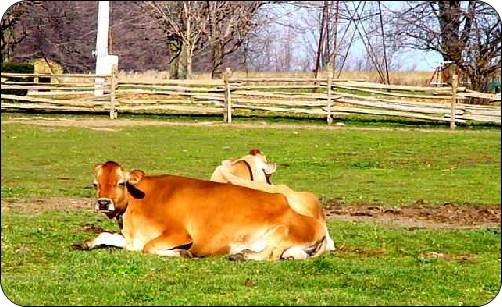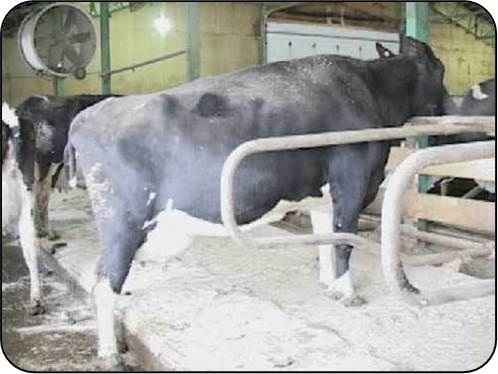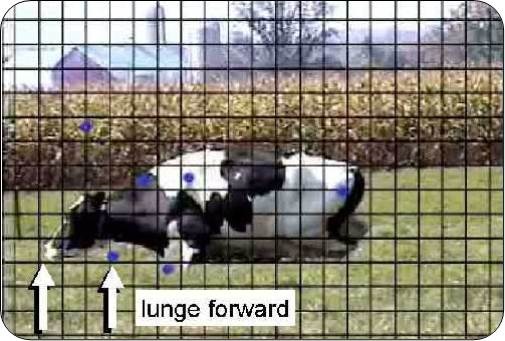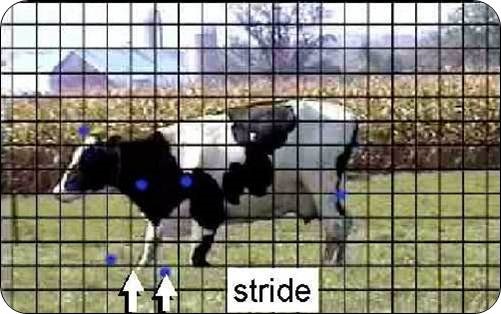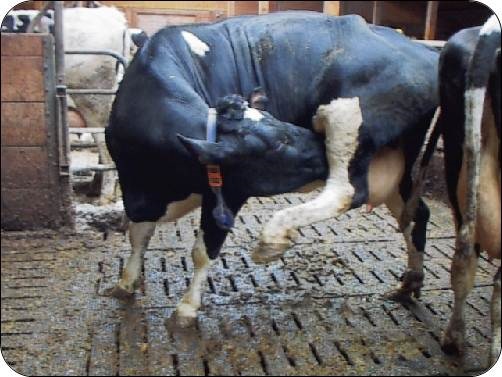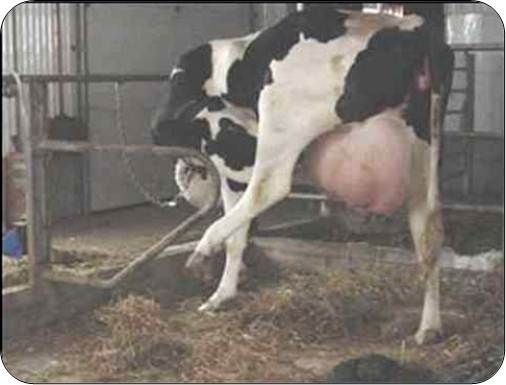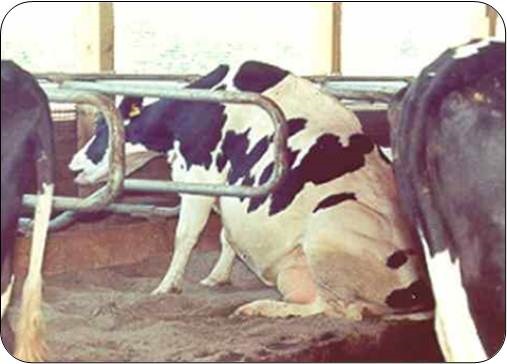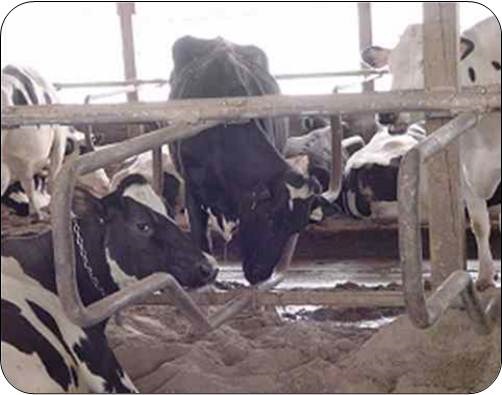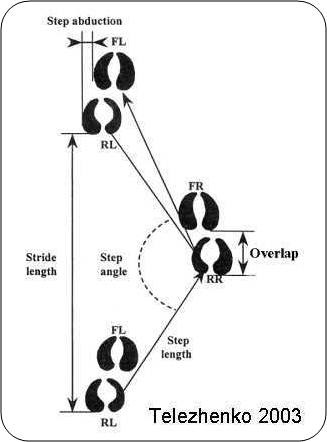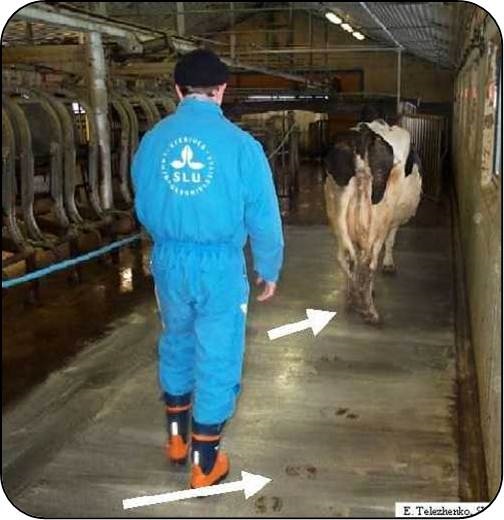Dairy cow comfort: using cow behaviour to judge free-stall versus tie-stall barns
Learn how choices in dairy cow stabling and management affect the behaviour, health, longevity and performance of cows and profit of a dairy farm.
Disclaimer
Since 2020, we recommend alternative barn designs instead of tie-stall barns for all new constructions.
Loose housing alternatives are the only viable long-term option due to the depreciation period of barns and their lifespan, and other considerations.
The Code of Practice for the Care and Handling of Dairy Cattle requires that “newly built barns must allow daily, untethered freedom of movement and social interactions year-round” effective April 1, 2024. For all existing barns, “effective April 1, 2027, cows must not be tethered continuously throughout their entire production cycle (calving to calving) — they must be provided sufficient regular opportunity for freedom of movement to promote good welfare.”
Concepts
Choices in stabling and management affect the behaviour, health, longevity and performance of cows and profit of a dairy farm. Fear or frustration with her workplace predisposes a cow to unwanted or abnormal behaviour and risk of disease. Cow behaviour and disease are gauges of cow comfort. Diseases related to housing and comfort include lameness, hock or neck injury, mastitis, milk fever, ketosis and displaced abomasum. Behaviours while resting, eating, walking or occupying stalls provide additional information about comfort. Positive interactions between a cow, her workplace and her caregivers lead to cow welfare, happy employees and a productive herd. (Anderson 2001)
Goals
In comfortable stalls, cows lie for 60% of the day and seldom perch or stand idly. The ideal stall has open forward space for normal rising and lying motions. It has no hazards that cause injury, pain or frustration. In addition, it provides space for all normal resting positions and allows cows to stand and lie straight. Cow and stall cleanliness are common in comfortable stalls. Cows should adapt to their environment easily, have ready access to feed, water and shade, and avoid injury in well-designed dairy housing. This document describes cow behaviour to look for when judging cow comfort in free-stall and tie-stall barns. The behaviours provide practical tests (indicators) of a housing system.
Resting (lying) positions
Resting describes lying in the stall in one of four normal resting positions - long, short, narrow or wide. In the long position, cows rest with their heads extended forward. In the short position, they rest their heads along their side and go into active sleep. While in the narrow position, a cow rests more on her sternum with the neck in a slight crook and the rear legs close to the body. Her front legs may or may not be extended. In the wide position, a cow rests more on her side with the rear legs extended. Another position is lateral recumbency where a cow lies totally on her side with legs and head extended.
Idle standing
Idle standing describes pointless positioning with all four feet in the free stall. It includes failed attempts at lying.
Stereotypic behaviours also may be seen with idle standing. These include pushing of the nose firmly against the stabling or grasping onto pipes.
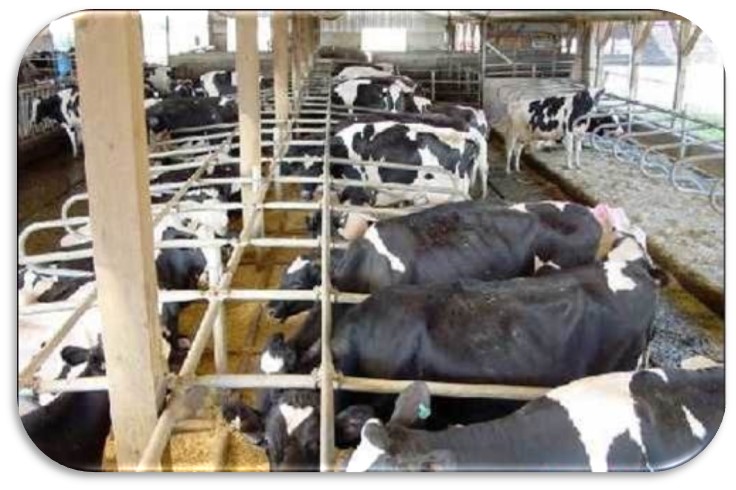
Some cows stand in a free stall and swing their heads repeatedly left and right, as if checking traffic before crossing a busy street. This activity has been described as "the hesitation waltz." In narrow tie stalls with dividers between every second cow, there may be inadequate space for both cows to lie at the same time.
In these barns, one cow must stand while the other lies. Cows may stand in stalls with soft beds when the alternative is concrete alleys. Standing may be more common with lame cows and firm bed surfaces. (Cook 2004)
Perching
Perching describes cows standing with their front feet in the stall and rear feet in the alley. The behaviour may also describe cows lying with part of their body in the stall and part in the alley. Claw horn diseases of the rear feet are more common in barns with features that encourage cows to perch. (Philipot 1994) In lying cows, perching contributes to contamination of udders, teats, legs and tails, and risks of mastitis. Bouts of perching may last for several minutes or greater than one hour.
Perching often accompanies efforts to control stall cleanliness through placement of neck rails to the rear of the stall, deterrents at the front of the stall, short beds or use of an uncomfortable resting surface. One research study showed that perching decreased as the width of free stalls increased from 44 to 52 inches.
In some tie-stall barns, cows perch with their front feet on the bed and their rear feet in the gutter. In these barns, the tethering system and a lack of headspace may contribute to the behaviour.
Diagonal standing and lying
Diagonal standing or lying describes the corner-to- corner use of a stall. This behaviour provides space for placing four feet in a stall, lunging, avoiding a cow in a facing stall or lying with body parts on the bed. Cows stand or lie diagonally in a stall because of a lack of space for standing or lying straight or lunging straight. They use the hypotenuse of an imaginary right-angled triangle in the stall to alert us to obstructions in their stalls.
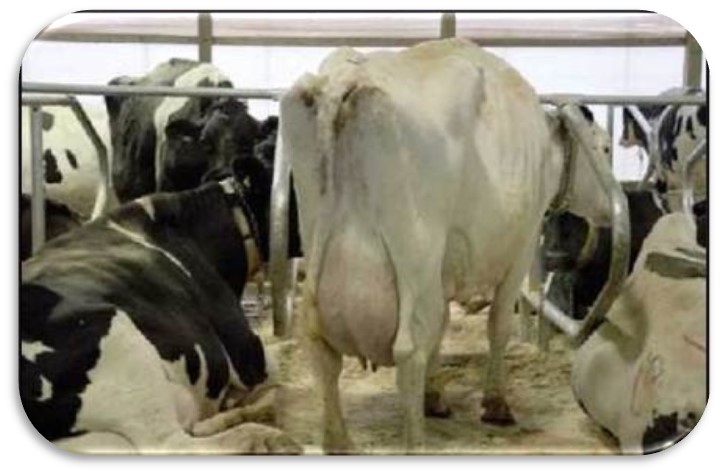
In some tie stalls, cows stand or lie diagonally because of narrow openings at the front, short beds and high manger curbs, location of the tie rail or position of the electric cow trainer.
Straight standing and lying — forward open space
Straight standing or lying describes cows positioned parallel to the dividing loops in a stall. Forward open space is the unobstructed space at the front of a stall.
It allows cows to stand, go down, lie and rise straight.
Straightness in the free stall, rapid entry and lying, infrequent standing and rare perching behaviour characterize stalls with adequate frontward open space. Forward open space is the reason for 18-foot head-to- head free stalls or 10-foot stalls facing a wall.
Lying backwards
Lying backwards describes cows resting with their heads facing the alley in free-stall barns. This unwanted behaviour leads to manure at the front of the stall and extra labour for cleaning.
Calves and heifers learn the behaviour when raised in ill-fitting free stalls. They often carry the behaviour into the milking barn. Some will persist with it even when stalls are adequate for normal behaviour. Mature cows adopt the behaviour to avoid frustrating or painful free-stall features. Some believe cows lie backwards because the free stalls are too wide. This may be true with free stalls wider than 54 inches - an extremely rare free stall. However, determined cows will lie backwards in stalls less than 48 inches wide. Lying backwards may be the most obvious of avoidance behaviours.
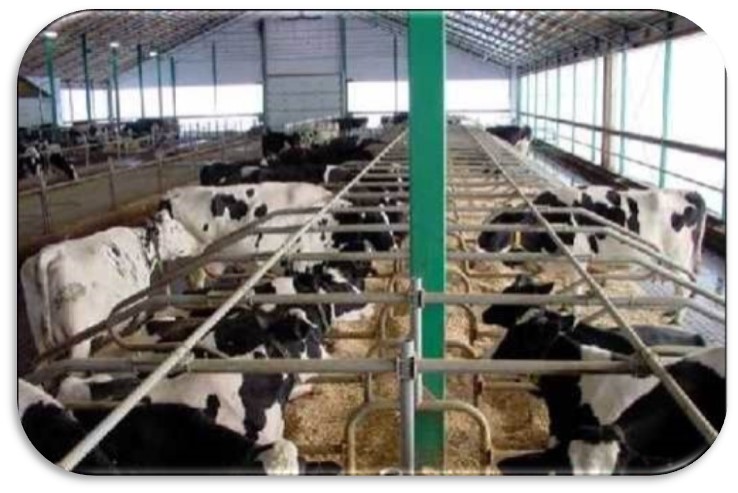
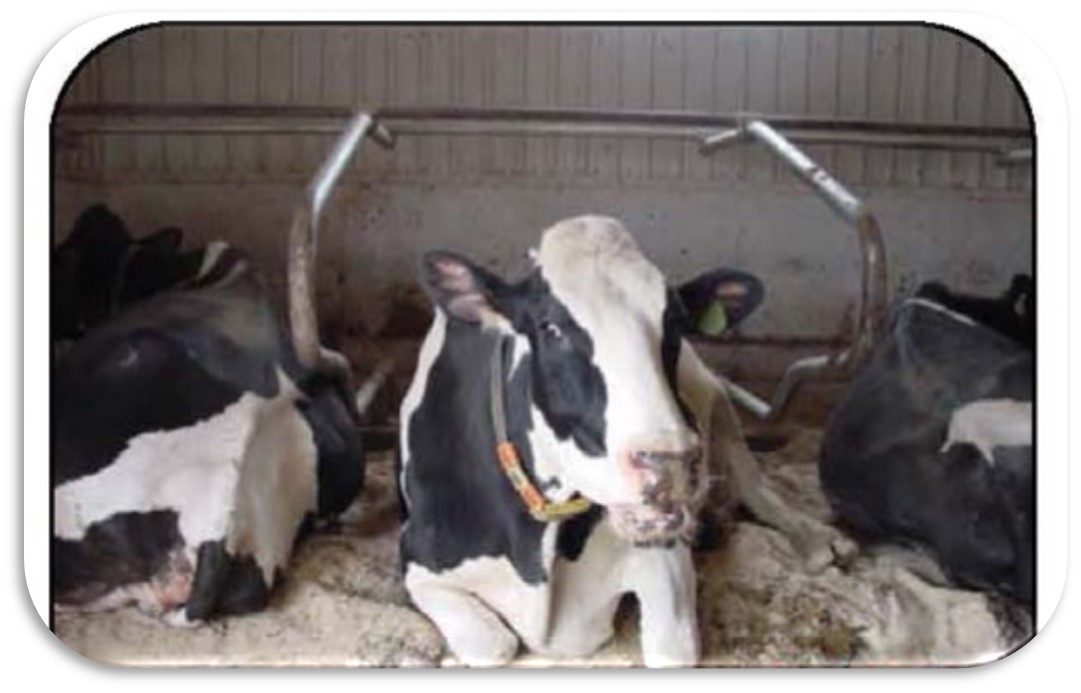
Restlessness or long bouts of lying
Restlessness describes cows fidgeting while lying or moving frequently from the narrow (upright) to the wide resting position.
When restless, the bottom rear leg moves over the bed, chafing the outside of the hock. In addition, the top leg falls off the bed into the alley, chafing the inside of the hock.
High brisket boards in free stalls and high manger curbs in tie stalls obstruct forward extension of the front legs and contribute to restlessness. Other obstructions, injuries or lameness make rising difficult or painful, so cows lie for long bouts without rising or changing sides for lying.
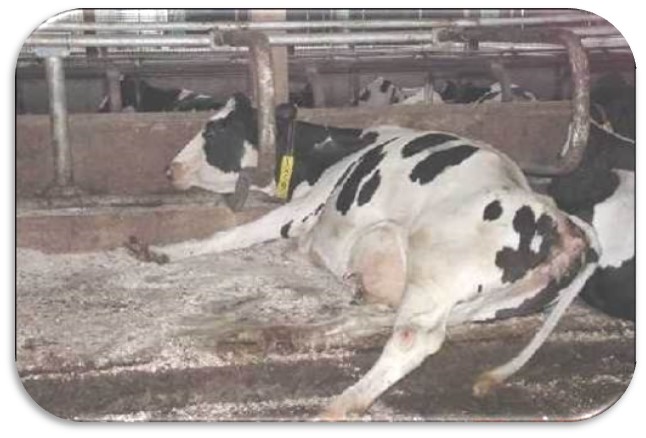
Alternate occupancy
Alternate occupancy describes cows lying in every other free stall with an empty facing stall.
It provides the opportunity for social space, unobstructed lunging and avoidance of a dominant cow in a facing stall.
Alternate occupancy is obvious in underpopulated pens where cows have a choice of an empty or occupied facing stall. Since cattle have a need for social space, their choice of adjacent companions depends upon age, temperament or difference in rank in the herd.
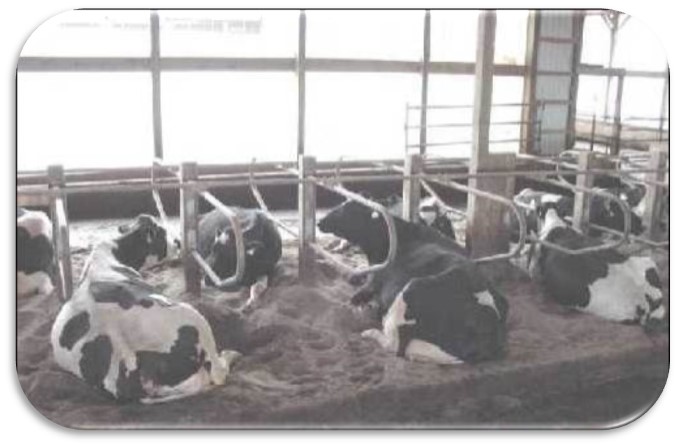
Bunching
Bunching describes cows standing for long times in an area of a free-stall barn while obviously avoiding another location. Ontario producers report bunching around water troughs or at ends of pens on summer days. Variations in temperature or air movement may lead to bunching. Overton (2002) found lying proportion decreased as pen temperatures increased with the highest mean proportion lying (86%) during the lowest recorded temperatures (58.8°F). In his conference presentations, Overton shows cows move away from the sun and into the shaded part of the barn. The percentage of cows standing increases as environmental temperatures increase (Shultz 1984). Standing maximizes evaporative cooling from body surfaces (Igono 1987). In Finland, Manninen (2002) found cows avoided sand and preferred straw and soft rubber mats in both winter and summer. His cows preferred straw to soft rubber mats in winter but there was no difference in summer.
Rising and lying motions
Rising and lying are normally continuous and smooth motions. They include a forward lunge and retraction and a bobbing down and up of the head. The head bobs downward until the chin touches ground level. It acts as a counterbalance for the hindquarters. Rising begins with the front quarters raising slightly and then the hindquarters follow, propelled by the rear legs. While rising, the shoulders move forward (longitudinal to body) about 16 inches and the head about 24 inches.
Any object in the range of normal motion obstructs rising and lying. Keen observation and listening help point to obstructions — for example, chin cuffers, skull smackers, withers whackers, foot bangers and knee knockers.
Cows cope by altering the normal bob, lunge and pendulum motions of the head and smooth motions become shuffles of the front and hindquarters. When coping with obstructions, the cow's head moves in an upward ski-jump type arc rather than a normal bob.
Caudal licking — grooming
Caudal licking describes cows using their tongue to groom the fold between their udder and leg. The behaviour should be of interest because it is an indicator of floor slipperiness. The behaviour also may be beneficial to prevent scalding between the leg and udder. To do so, they stand on their two front legs and one hind leg, as shown in Figures 11 and 12.
In traditional tie-stall barns and older stanchion barns, the tethering system may prevent caudal licking. An 18-21-inch chain in a single tie-rail system does not permit caudal licking for the majority of cows. A double-chain system ("Comfort Stalls" in Ontario) also does not allow for the behaviour.
Kneeling cow syndrome
Kneeling Cow Syndrome (KCS) describes dairy cows kneeling on their fore knees while standing upright on their hind legs. Caregivers dislike KCS because these cows defecate within the stall bed. Contaminated beds lead to dirty teats and udders, increased udder preparation time, risks of mastitis and risks to milk quality.
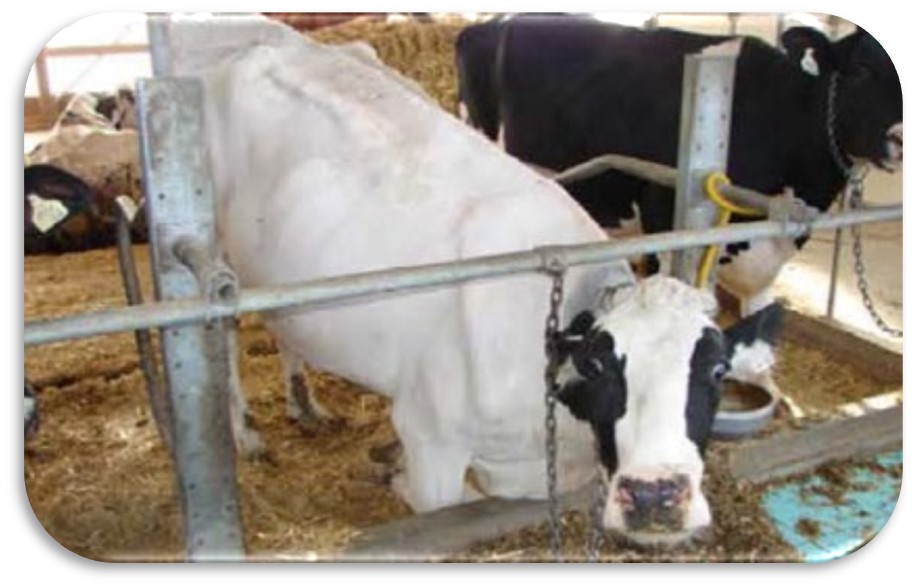
In tie stalls, cows kneel to avoid malpositioned electric trainers - trainers that are too close to their top line or forward of, and lower than, the withers. They also kneel to reach feed when the manger is at, or below, their foot height. In addition, cows kneel to get to feed beyond their reach.
Some cows spread their feet apart laterally to lower shoulder and head height to make feed more accessible. This stance stresses the inside claw of the front foot and may contribute to sole ulcers. Cows with laminitis may kneel while eating.
In tie and free stalls, cows may kneel for extended times in response to obstructions to normal rising or lying. The obstructions are typically in their head bob and lunge space but also may include a malpositioned neck rail in free stalls.
Dog-sitting behaviour
Dog sitting behaviour describes cows that sit like dogs on their hindquarters with their front legs extended. The behaviour also may be described as rising like a horse, with the front end before the hindquarters.
The behaviour should alert us to several stall features that create discomfort for the cow. It also may indicate an injury to a front leg. Cows with injuries to a knee often rest with the leg in extension because swelling limits their ability to fold it. Of necessity, those cows also choose to extend both forelimbs and rise like a horse.
However, cows without injured forelegs also choose to sit like dogs and rise like horses. In tie-stall barns with comfort stalls, some cows cannot cope with the lack of lunge space and short chains that restrict forward lunging. They cope by rising like horses and often sit like dogs for several minutes. In free-stall barns with obstructions to normal rising and lying behaviour, one or several cows may exhibit dog-sitting behaviour. In Figure 14, note the 12-inch brisket board and the neck rail 46 inches above the bed. These may be obstructions that caused her pain and fear and subsequently altered her normal rising behaviour.
Dog-sitting behaviour should not be confused with frog posture that describes full or partial extension of both hind legs forward along the sides of the recumbent body. In cattle, frog posture is an indicator of hip dislocation, rupture of the adductor muscles or paralysis of the obturator nerve.
Stereotypy — nose-pressing
Stereotypy describes excessive repetition of apparently purposeless behaviour. Stereotyped behaviour is abnormal and one form of behavioural response to a stressful or difficult condition.
The nose-pressing behaviour shown in Figure 14 may be unnoticed or viewed as normal for certain cows in a herd. However, it may be indicative of shortcomings in the housing that stress cattle.
The stressful condition causing the stereotypy may be difficult to identify or it may involve several factors.
By chance, video recordings in a tie-stall barn captured the nose-pressing stereotypy of a mature Holstein cow. The stall had a wide opening, a single tie-rail (40 inches above the bed) and an 18-inch tie chain to a leather neck strap. The bed length was 66 inches from manger curb to gutter curb. The stall was 46 inches wide and it had two vertical support posts located 12 inches forward of the gutter curb. The cow's lying time was about 8 hours in a 24-hour period. When going down to rest, her hips contacted the support posts. While standing idly (not eating, ruminating or milking), she pressed her nose repeatedly into the tie-rail support post and she danced constantly from foot-to-foot. She had no signs of foot disease. A combination of stall features could have led to her nose-pressing behaviour.
Stalls and behaviour — resting, standing, perching
Visitors to barns often assess cow behaviour and stall comfort during their cameo appearance. They look for resting, standing and perching times as measures of a cow's reaction to her stall. The impression may or may not be correct. Although more time consuming, time- lapse video recordings show what may not be obvious during a cameo appearance.
Conventional indicators (for example, stall usage index) do not measure stall lying times. However, stall-standing behaviour is an important behaviour modification associated with increased rates of lameness in compromised environments. (Cook 2004, 2005) Cook advises observing two hours before the morning milking. Overton (2002), in California, advises assessing stall usage one hour before the morning feeding or milking. He observed changes in standing behaviour associated with sunlight and temperature in the barn.
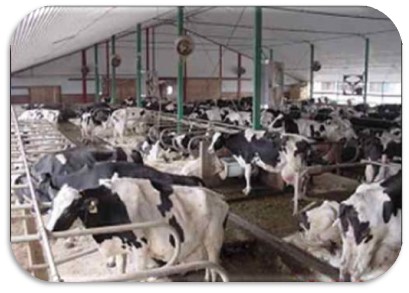
Ceballos (2004) provided the first 3-dimensional studies, describing accurate measures of space used by Holstein dairy cows during lying-down movements in an open space and in a free stall. He showed cows use up to 300 cm (10 feet) of longitudinal space when lying down. This is more space than provided in conventional free stalls. Nose movements clustered at 10-30 cm (4-12 inches) in the forward lunge space. This report should alert us to keeping this space free of obstructions.
Hardware and dimensions alter cow behaviour and preference in stalls. In wider stalls, Casandra Tucker (2004) found animals spent more time lying down and less time standing with only the front hooves in the stalls. Brisket boards make stalls less comfortable. Cows prefer stalls without brisket boards and stall usage declines when boards are present. However, brisket boards position cows and contribute to stall cleanliness. (Tucker 2006) Brisket board height of more than 15.24 cm and presence of the area behind the brisket board filled with concrete were associated with greater prevalence of lameness in a US study. (Espejo 2007) Neck rail height and forward location alter stall cleanliness and standing and perching times but not lying times. Tucker (2005) advises adjusting the location so cows can stand with four feet on the beds of stalls with rubber-filled mattresses or rubber mats.
The type and amount of bedding alter stall usage. In British Columbia, Drissler (2005) found greater lying times (as much as 2.3 hours per day) in sand-bedded stalls when sand was at the level of the curb rather than 14 cm (5 inches) below the curb. It is common practice in Ontario to bed stalls and store sand in stall fronts with bi-weekly or monthly maintenance. However, there is no research showing the effects piles of sand have on lying or standing times. Tucker (2004) reported significant increases in lying times (1.5 hrs/d) and bouts of lying, and decreases in perching, with 7.5 kg sawdust compared to 1 kg on rubber-filled mattresses. Obviously, cows preferred rubber-filled mattresses with lots of bedding. Other research (Mowbray 2003, Tucker 2004) from British Columbia has shown fewer hock lesions with well-bedded mattresses. Cows prefer a comfortable surface for lying and standing and stall surface affects preference and usage. (Tucker 2003) Higher stocking rates decrease lying times and cows spend more time standing in alleys. There also are more displacements of cows from stalls. (Fregonesi 2004) Under conditions of heat stress, cows choose stalls with wood shavings or solid bedding over rubber mats. (De Palo 2006)
Dairy cattle with access to rubber flooring in front of the feeder showed small differences in where and how much time they spent standing, although the biological implications of these small changes are unclear. (Fregonesi 2004) Cows are more willing to move on and spend more time standing in front of the feed bunk when provided with softer flooring. (Tucker 2006) Cows spend considerably more time standing when close to calving suggesting cow comfort may be important at this time. (Huzzey 2005) Cow behaviour differs for free-stall-housed cows with slatted concrete, mastic asphalt and rubber mat flooring surfaces. Cows with the rubber floor spent less time lying in stalls and more time at the feed bunk, in the alley and standing in stalls. Cows in the unit with the rubber floor did not have the same need to be lying down; instead, they stood on soft footing while resting, or spent more time at the feeding table. The total 12 hours per 24-hour period spent lying, when the rubber flooring in the passages was used, was more equivalent to lying behaviour observed in grazing dairy cattle than that of cattle housed on hard flooring. (Olsson 2005)
Obstructions that restrict normal rising and lying, or stall features that cause pain, fear or frustration, can result in unwanted or abnormal behaviour. Through their behaviour, cows point to barn features that cause them discomfort — walls, boards, pipes, bedding, ropes or nylon straps in the forward space needed for lunging and bobbing the head. Other discomfort items include narrow stalls, short beds, narrow openings in loops for side-lunging stalls, neck rails that are too low or too close to the rear of the stall, high brisket boards, high curbs and lack of suitable bedding.
Walking
A healthy cow walking on pasture places the rear foot into the position vacated by the front foot on the same side. On slippery floors or in dark conditions that alter a cow's confidence, she places her rear foot outside the track of the front foot, alters stride and step length and walking speed. This altered walking behaviour provides greater stability but places greater stress on the outside claw.
Choices of flooring and lighting influence walking behaviour, foot health and cow movement. Foot placement, length of stride and step and walking speed are a few items of locomotion pointing to walking behaviour. (Telezhenko 2003, 2005)
Observation of walking patterns provides an opportunity to assess floors for traction and flatness of surface for the claw to rest upon.
In addition, "birdbaths" in concrete floors are health risks that pool wastes, contaminate feet and tails and allow splashing onto beds, teats or legs.
In Germany, researchers found less slipping on soft rubber floors. Step length on soft, rubber-slatted floors was similar to that measured on pastures. Activity and walking speed increased on soft floors. Claw health was improved on soft, slatted floors compared to usual slatted floors. (Jungbluth, Benz 2003)
Resources to help plan your dairy barn
- Dairy housing: developing the plan and procuring services and materials for constructing a new dairy barn
- Milking centre design and construction for parlour milking
- Positive pressure air tube ventilation for calf housing
- Lighting options for free stall housing
- Dairy housing - layout options
- Dairy housing: ventilation options for free stall barns
- Floor finish options for dairy free-stall housing
- Dairy housing: compost-bedded pack barns
- Using separated manure solids for compost bedding
- Dairy housing: free-stall base material and bedding options
Reading list
Anderson NG. Time lapse video opens our eyes to cow comfort and behavior. Proc American Assoc Bovine Practitioners Conference 2001;34:35-42.
Anderson NG. Observations on dairy cow comfort: diagonal lunging, resting, standing and perching in free stalls. Proc 5th Int'l Dairy Housing Conference, ASAE 2003:26-35.
Ceballos A, Sanderson D, Rushen J, Weary DM.
Improving stall design: Use of 3-D kinematics to measure space use by dairy cows when lying down. J Dairy Sci 2004;87(7):2042-2050.
Cook NB, Bennett TB, Nordlund KV. Effect of free stall surface on daily activity patterns in dairy cows with relevance to lameness prevalence. J Dairy Sci
2004;87(9):2912-2922.
Cook NB, Nordlund KV, Oetzel GR. Environmental influences on claw horn lesions associated with laminitis and subacute ruminal acidosis in dairy cows. J Dairy Sci 2004;87(13_suppl):E36-46.
Cook NB, Bennett TB, Nordlund KV. Monitoring indices of cow comfort in free-stall-housed dairy herds. J Dairy Sci 2005; 88(11):3876-3885.
Cook NB, Nordlund KV, Oetzel GR. Environmental influences on claw horn lesions associated with laminitis and subacute ruminal acidosis in dairy cows. J. Dairy Sci. 2004; 87:E36-46.
De Palo P, Tateo A, Zezza F, Corrente M,
Centoducati P. Influence of free-stall flooring on comfort and hygiene of dairy cows during warm climatic conditions. J Dairy Sci 2006;89(12):4583-4595.
Drissler M, Gaworski M, Tucker CB, Weary DM.
Freestall maintenance: effects on lying behavior of dairy cattle. J Dairy Sci 2005;88(7):2381-2387.
Espejo LA, Endres MI. Herd-level risk factors for lameness in high-producing Holstein cows housed in freestall barns. J Dairy Sci 2007;90(1):306-314.
Fregonesi J, Tucker C, Weary D, Winckle C. Higher stocking rates reduce lying time. Proc 22nd Annual Western Canadian Dairy Seminar, Red Deer, AB, March 9-12, 2004.
Huzzey JM, von Keyserlingk MAG, Weary DM.
Changes in feeding, drinking, and standing behavior of dairy cows during the transition period. J Dairy Sci 2005;88(7):2454-2461.
Igono MO, Johnson HD, Steevens BJ, Krause GF, Shanklin MD. Physiological, productive, and economic benefits of shade, spray, and fan system versus shade for Holstein cows during summer heat. J Dairy Sci 1987;70:1069-1079.
Jungbluth T, Benz B, Wandel H. Soft walking areas in loose housing systems for dairy cows. Proc 5th Int'l Dairy Housing Conference, ASAE 2003:171-177.
Manninen E, de Passillé AM, Rushen J, Norring M, Soloniemi H. Preferences of dairy cows kept in unheated buildings for different kind of cubicle flooring. Appl Anim Behav Sci 2002;75:281-292.
Mowbray L, Vittie T, Weary DM. Hock lesions and free-stall design: effects of stall surface. Proceedings 5th Int'l Dairy Housing Conference, ASAE 2003:288-295.
Olsson J, Magnusson M, Ventorp M. The effect of the passage flooring in cubicle houses on the behavioural time-budget of dairy cows. Proc Int'l Soc Anim Hygiene. 2005;2:140.
Overton MW, Sischo WM, Temple GD, Moore DA.
Using time-lapse video photography to assess dairy cattle lying behavior in a free-stall barn. J Dairy Sci 2002;85(9):2407-2413.
Philipot JM, Pluvinage P, Cimarosti I, Sulpice P, Bugnard F. Risk factors of dairy cow lameness associated with housing conditions. Vet Research 1994;25(2-3):244-248.
Shultz TA. Weather and shade effects on cow corral activities. J Dairy Sci 1984;67:868-873.
Telezhenko EV, Bergsten C, Manske T. Cow locomotion on slatted and solid floors assessed by trackway analysis. Proc 12th Int'l Symposium on Lameness of Ruminants, Orlando, FL, USA. 2003:417-419.
Telezhenko E, Bergsten C. Influence of floor type on the locomotion of dairy cows. Appl Anim Behav Sci. 2005:93 (3-4):183-197.
Tucker CB, Weary DM, Fraser D. Effects of three types of free-stall surfaces on preferences and stall usage by dairy cows. J Dairy Sci 2003;86(2):521- 529.
Tucker CB, Weary DM, Fraser D. Free-stall dimensions: effects on preference and stall usage. J Dairy Sci 2004;87(5):1208-1216.
Tucker CB, Weary DM. Bedding on geotextile mattresses: how much is needed to improve cow comfort? J Dairy Sci 2004;87(9):2889-2895.
Tucker CB, Weary DM, Fraser D. Influence of neck- rail placement on free-stall preference, use, and cleanliness. J Dairy Sci 2005;88(8):2730-2737.
Tucker CB, Weary DM, de Passillé AM, Campbell B, Rushen J. Flooring in front of the feed bunk affects feeding behavior and use of freestalls by dairy cows. J Dairy Sci 2006;89(6):2065-2071.
Tucker CB, Zdanowicz G, Weary DM. Brisket boards reduce freestall use. J Dairy Sci 2006;89(7):2603-2607.
